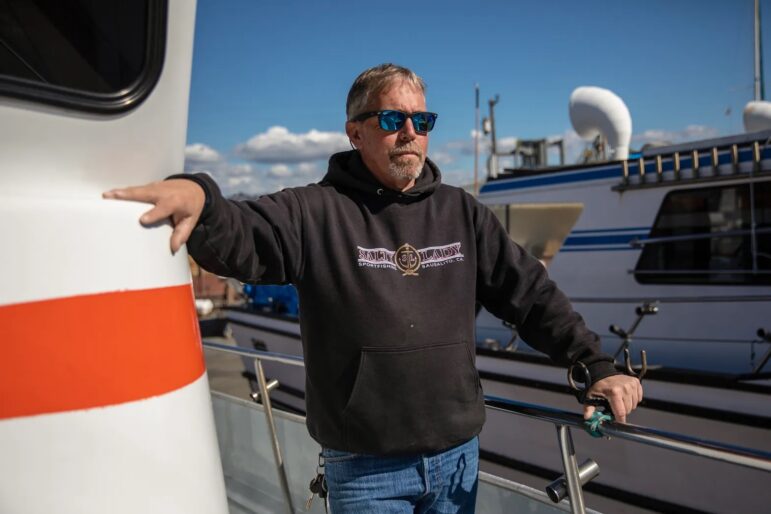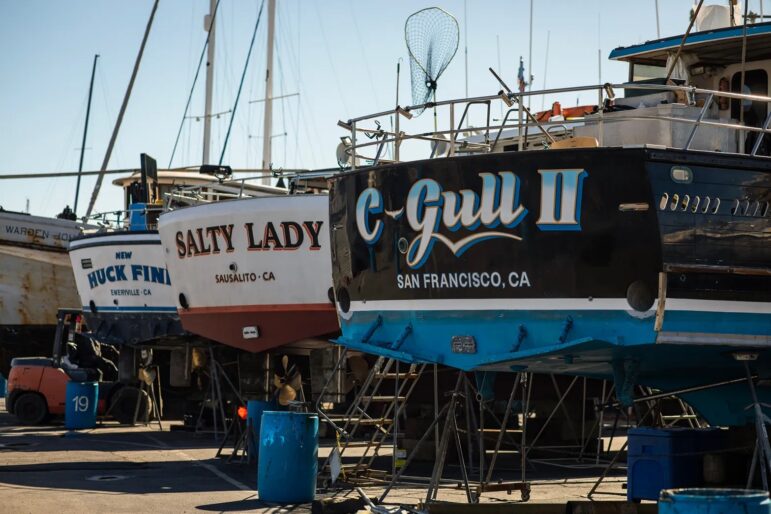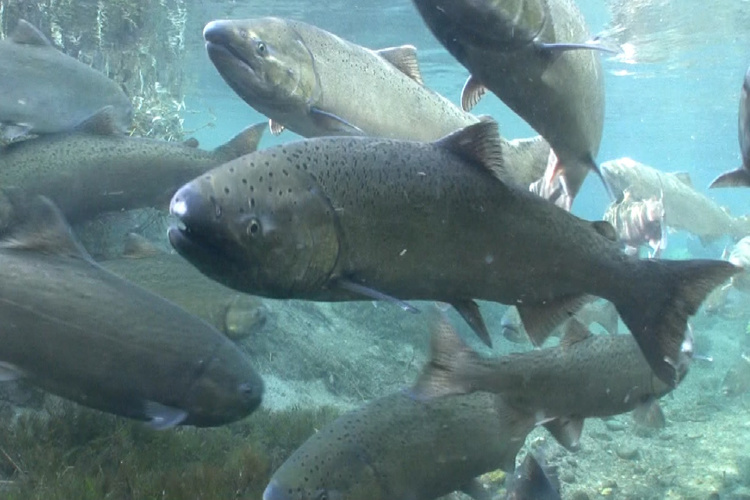California’s fishing industry is bracing for another bad year as federal managers today announced plans to heavily restrict or prohibit salmon fishing this year, following a complete ban last year.
The Pacific Fishery Management Council today released a series of options that are under consideration, all of which either ban commercial and recreational salmon fishing in the ocean off California or shorten the season and set strict catch limits. The council’s final decision is expected next month; the commercial season typically begins in May and ends in October.
While more Chinook salmon returned from the ocean to spawn last year than in 2022, fishery managers said the population is expected to be so small that they must be protected to avoid overfishing.
Fall-run Chinook salmon are a mainstay of commercial and recreational fishing and tribal food supplies. But their populations are now a fraction of what they once were — dams have blocked vital habitat, while droughts and water diversions have driven down flows and increased temperatures, killing large numbers of salmon eggs and young fish.
The plan is a devastating blow for an industry still reeling from last year’s closure. State officials estimate that last year’s closure cost about $45 million — which the fishing industry says vastly underestimates the true toll.
“There’s no way to sugarcoat it, as it’s simply catastrophic,” said Scott Artis, executive director of the Golden State Salmon Association, which represents the commercial and recreational fishing industry, other businesses, restaurants and environmentalists.
“The fishing industry and many thousands of salmon families and businesses eagerly waiting to get back to work are potentially facing another year in the harbor instead of putting food on the table.”
The options are likely to evolve as the Pacific Fishery Management Council continues to analyze them over the next month. Two call for significantly shortened seasons and harvest limits for both commercial and sport fishing off California this year. The third would cancel the season for the second year in a row.
“In response to poor river and ocean conditions, California stocks are forecast to have 2024 abundance levels that are well below average,” Marci Yaremko, the California Department of Fish and Wildlife’s appointee to the Pacific council, said today. “The options that have been developed that do authorize some fishing are very precautionary.”
Harvest limits and other restrictions on the number of fish caught per trip are new concepts for managing ocean salmon fisheries, Yaremko said.

“Even the best option that they give us there is crumbs compared to a regular salmon season,” said Jared Davis, captain of the Salty Lady, a charter fishing boat.
Still, of all the options, he said, he’d prefer complete closure. The shortened seasons don’t offer enough days to sustain his business and the potential repercussions aren’t worth it.
“I think fishing on low abundance such as we have this year is reckless and irresponsible,” he said. “It’s really playing with fire for us to take any fish out of there.”
Sarah Bates, who owns a commercial fishing boat berthed at Fisherman’s Wharf in San Francisco, called the decision “tragic.”
“We’re looking at numbers of fish that don’t even make it worthwhile to untie the boat,” she said. “It’s not enough fish to pay for the maintenance and preparation.”
RJ Waldron, 48, put his sportsfishing boat, the Sundance, up for sale in January. When the salmon season closed last year, an estimated 85% of his business dried up. Few clients took him up on his offer to switch to halibut, striped bass or rockfish.
Buying the boat eight years ago to run a charter fishing business out of the East Bay had been a dream come true for Waldron, a long-time fishing and hunting guide.
“Basically this last year, I’ve just been blowing through my cash, blowing through the savings, just trying to stay afloat,” Waldron said. “I put everything I had into this fishing business, into the salmon. And it’s totally out of my control. I can’t resurrect it.”
California’s commercial fleet and recreational anglers still await federal disaster aid for last year’s losses. The federal government allocated only $20.6 million in disaster funding, and a year later, none of the salmon fishers CalMatters interviewed has received a check.
Waldron called the lack of disaster aid a “big slap in the face.”
Davis said he tried to weather the storm by arranging trips for halibut, striped bass, rockfish and lingcod. Still, he estimates that his business was down 80% from a normal year.
Seeing the season restricted this year, “breaks my heart,” he said. “It’s what I love, and it’s a passion. It’s something I’ve been doing my whole life, and I know that there’s a lot of others in the industry that it’s the same for.”
Salmon fishers fear the closure will drive yet more boats permanently from the fleet — already down to 464 vessels in 2022 from nearly 5,000 in the early ‘80s. Recreational salmon fishing trips plummeted from nearly 99,000 in 2022 to zero last year.
Bates estimates that about half the fleet picked up shore jobs. And some, she said, probably won’t return.
“Some people, I’m sure, will not go fishing again,” she said. “They got a job that will hold them through and their momentum will shift, and I’m sure we’re going to lose members of our fleet.”
To make ends meet last year, Bates picked up bookkeeping work. But she doesn’t know yet what she’ll do this year. Bates’ boat is called the Bounty, a cruel irony the past year. Still, she said the boat has seen bad seasons before — and it’s bad luck to change a boat’s name, she said.

Tommy “TF” Graham also will keep working on land. A commercial fisherman based in Bodega Bay, he got a Class A driver’s license so he could drive a truck and stay afloat through the closures. Now, when he’s not crab fishing, Graham wakes up at 3 a.m. to drive frozen and farmed salmon and other fish from around the world into San Francisco.
“A guy has got to get up and put his boots on and go to work every day,” Graham said. Still, he said, “I used to be a provider, now I’m a consumer. It feels like shit, to tell you the truth.”
Tribes with subsistence fishing do not have to follow the federal recommendations, although they often cancel or heavily restrict their own seasons.
Today’s decision follows the release of population numbers that industry experts called disastrous.
Sacramento River fall-run Chinook make up the greatest proportion of the California and Oregon ocean salmon fisheries. Their numbers are down from an average of more than 200,000 fish that returned to spawn in the mid-2000s. And those numbers are a fraction of the historical counts of between one and two million fall and spring-run salmon returning to the Central Valley every year.
Last year, fewer than 134,000 returned to the Sacramento River. That’s more than double the fish that returned in 2022, which was the third lowest count on record. But it barely cleared the federal government’s minimum conservation target of 122,000 fish, and falls 19% short of the number that had been projected to return — despite the cancellation of all salmon fishing.
Now, scientists estimate that 213,606 Sacramento River fall-run salmon are swimming off the coast. It’s more than last year — more even than the upper limit of the fishery’s conservation target. But it is still the second lowest projection in a decade, according to a guidance letter from the National Marine Fisheries Service. “Caution is warranted to reduce the chances that the stock becomes overfished again.”
Federal officials attributed the struggling populations in part to low flows and high temperatures on the Sacramento River during California’s drought in 2021, when the fish returning this year were spawned.
But the salmon industry also points to state and federal management of the Sacramento River and operations of the vast Central Valley Project, which funnels water south from Northern California’s rivers to irrigate a third of the state’s agricultural land and supply a million households.
In 2021, almost all of the endangered winter-run Chinook eggs in the Sacramento River were wiped out, cooked in dangerously hot water. The Pacific Fishery Management Council told state and federal water managers in 2022 that the conditions also could harm eggs of spring-run and fall-run Chinook salmon. Expressing their “grave concerns,” they said “a major factor” was the “high river temperatures that were under (the U.S. Bureau of) Reclamation’s control.”
The Newsom administration has come under fire from conservationists and the fishing industry for actions that could jeopardize salmon, including waiving water quality requirements in the Delta and backing a controversial pact with major water suppliers related to diversions from the Bay-Delta watershed.
“It’s really hard for me to swallow that we export all this water and have little to no regulation on the farming,” Waldron said. “We’re taking away from a resource to give to another resource. And I don’t understand how we can let that happen, especially (since) the salmon are a natural resource.”
The Newsom administration unveiled a plan in January aimed at protecting and restoring salmon “amidst hotter and drier weather exacerbated by climate change.”
